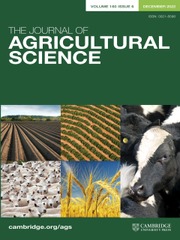Article contents
Effect of conceptus growth on the contents of the maternal gastrointestinal tract in ewes fed at a constant rate throughout gestation
Published online by Cambridge University Press: 27 March 2009
Summary
Multiparous Corriedale ewes were maintained on a constant feed intake such that the body weight (i.e. live weight less gravid uterus) of single-bearing ewes at the end of gestation approximated their live weight at mating. The ewes were allocated to one of five groups, designated for slaughter at 0, 50, 90, 120 and 140 days of gestation. At slaughter, the gravid uterus was removed, weighed and its components dissected out and the contents of all sections of the gastro-intestinal tract were removed, weighed and sampled.
Foetal growth was described by a Gompertz model. It was predicted that, at day 150, a twin foetus would have been 0·95 of the weight of a single foetus but this difference was not statistically significant. The foetal proportion of the gravid uterus followed a sigmoid curve during gestation to reach a predicted value of 0·60 at day 150. Predicted birth weights represented 10·4 and 18·6% of maternal body weight in single- and twin-bearing ewes.
The digesta content of the rumen and of the whole gastro-intestinal tract was not significantly affected by gestation. However, there was a tendency for the values to decline to day 90, then increase during the last third of gestation. It was suggested that the decline was due to hormonal rather than direct physical effects. By contrast, the amounts of organic digesta constituents in the rumen descreased as gestation progressed (P < 0·01) indicating an effect of gestation on rumen propulsive activity.
Information
- Type
- Research Article
- Information
- Copyright
- Copyright © Cambridge University Press 1988
References
- 1
- Cited by

